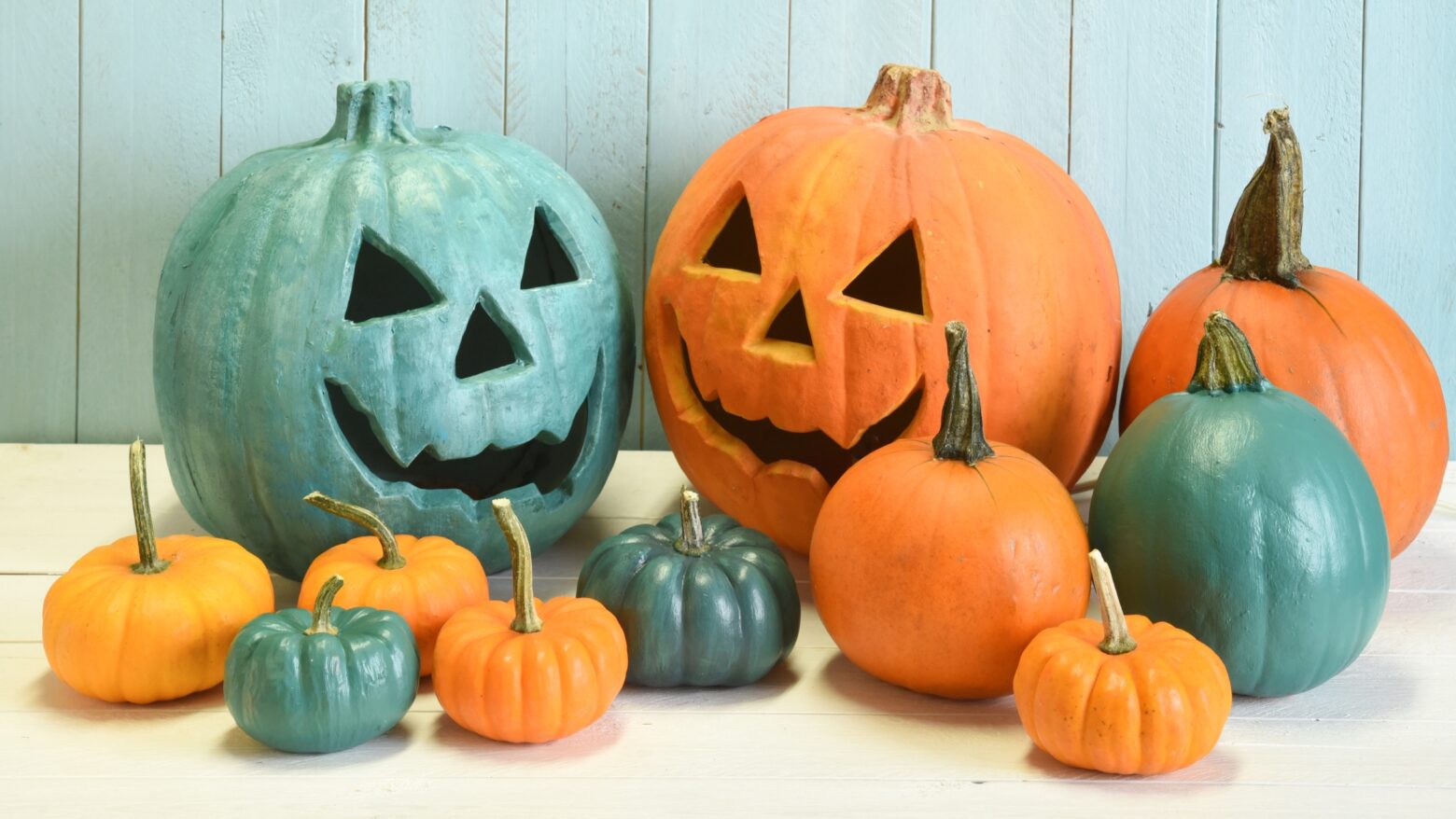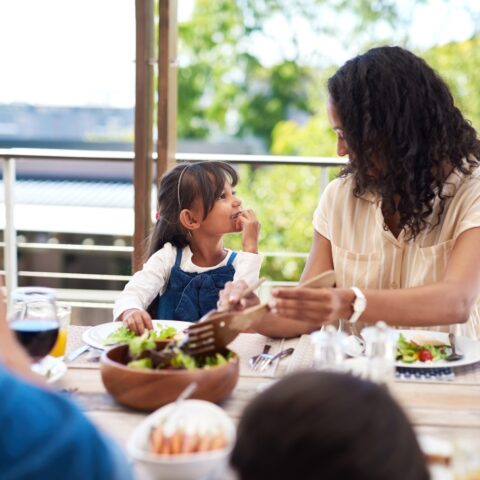Embracing Inclusivity in Halloween Traditions with the Teal Pumpkin Project

Each year at the end of October in the U.S., families and friends stroll through their neighborhoods, knocking on any lighted door for a multifaceted quest. Each cluster keeps tabs on which house has the best decorations; people-watching is at an all-time high looking for the best costumes; and extra squeals can be heard when bowls are filled with king-size anything, let alone the best of the best treats.
And if you were trick-or-treating with my family in the ’90s, the ultimate prize (the sweetest combination of pride and bragging rights for a whole year) was given to the trick-or-treater who hauled home the heaviest pillowcase at the end of the night. Ironically, we measured this using the bathroom scale that was used every other day of the year to track an adult’s weight loss rather than a child’s candy gain. I can’t remember what year it was or how old we were, but the record in our house was somewhere between 10-15 pounds of candy in one pillowcase—the perks of suburbia as we saw it.
Halloween is an exhilarating holiday where young and old can find endless ways to participate and watch the world around us come to life—or celebrate the unalive, however you choose to celebrate. It also taps each of our five senses, making the holiday even more all-encompassing and intriguing.
It’s a holiday that keeps us on our toes at every corner and in every movie, and rewards both courage and creativity with the delight of sweets, the awe of excess, and a universally encouraged opportunity to show up in a way we don’t normally dress or behave.
There’s no doubt this holiday is cherished among countless, and with so many ways to celebrate, most have found ways to customize the holiday for what interests and works best for them. Just like the tradition of trick-or-treating, Halloween is a “take what you want and leave the rest” holiday, a real choose-your-own adventure.
Certain activities once deemed tradition started to fade out decades ago and are mostly only present now in movies and TV shows that depict earlier times. Think: bobbing for apples in a communal cauldron, neighbors or strangers passing out homemade cupcakes and cookies, and teens getting together the night before to wreak havoc on neighbors’ lawns with eggs and toilet paper.
Making Room for Sweets on Halloween
But one theme that continues to persist with each Halloween no matter the years that pass, is sweets. It’s not only socially acceptable, but also often encouraged to indulge and give into the desires of one’s sweet tooth. The significance placed on sweets at Halloween rivals that of the carved pumpkin and the costume, just like the significance of chocolate at Valentine’s Day rivals the significance of flowers and the love letter.
Back in the ’90s, major TV shows and news networks would advise parents about dangerous chemicals or objects placed inside homemade goods by ill-meaning, real life villains. The concept of normal and untampered storebought candy causing harm to someone wasn’t really considered. The occasional child with a nut allergy was unfortunately an afterthought (or worse, not thought of at all) and, at least in our area, we had never heard of the word “gluten” nor met a real-life vegan.
RELATED: Spooky Ingredients to Watch Out for in Candy
The only reason we didn’t eat what we collected was due to a damaged or missing wrapper (this included fresh produce from the “healthy houses”), a parent collecting a “trick-or-treating tax” when they noticed their favorite candy in our stash, an item being inedible altogether (plastic knick-knacks and tiny toys were perceived as a letdown), or a strong personal distaste for a particular candy. But even the last of those became grounds for negotiation and bartering for a different candy.
Allergen-Aware Trick-or-Treating Options
It wasn’t until the late ’90s when the concept of food allergies having real health consequences started to truly hit the mainstream, and peanuts were one of the first ingredients to pave the way. Many of us remember those initial notes sent home from schools, describing what a food allergy was and the exact reaction that child would have if exposed to or having consumed that ingredient. A large emphasis was often placed, on only what was most obvious to a bystander and lethal to the person allergic: anaphylaxis.
Airplanes even slowly started to consider that peanuts—the staple mid-flight snack—therefore shouldn’t be the only snack available on flights, and sometimes, not offered at all. Since food is such a core consideration of many rituals and traditions, and the center of many aspects of community, it would make sense that with more information, more progress, and more time passing, what we consume and consider as accepted tradition, would likely need to evolve—or at least become more considerate, too.
Decades ago, our parents, like many, attempted to mitigate our candy intake in the weeks following Halloween, with the three concerns being getting a cavity, bouncing off the walls, and filling up on sugar before we had a chance to eat dinner. The solution was for each of us to put our final candy collection in one of the individual drawers of a plastic organizing bin in the kitchen pantry. There was an arbitrary daily consumption allotment permitted, but even with all the candy being stored in a common area for all to witness, it was still hard to monitor let alone understand the comprehensive impact of this consistent consumption.
Little did we know that certain signs and symptoms we then tossed up as an occupational hazard to the gluttony of the holiday, were in fact cues that some of us were not tolerating certain ingredients found in the most classic and cherished candies. It would take just as much time, if not longer, to also grasp that the sheer amount of sugar was way too much to be consumed in a short period of time for each of us.
Connecting the dots that Halloween kicked off a three-month-long steady and constant increase in blood sugar until the resolutions of the new year would deem those behaviors no longer acceptable. If we trick-or-treated as an extended family today, we’d now be equipped with the knowledge that one of us cannot eat gluten, another definitely cannot have anything with eggs in it, another has to monitor their blood-sugar levels very closely, some may have a hard time managing portions of sweets, some won’t sleep a wink if we were to eat any treats at all later in the evening, and so on goes the list of a variety of other allergies, sensitivities, and inflammatory reactions. It would be difficult doing it back then, but thankfully, we have more information, resources, and plenty of options now. We can customize this exciting holiday to meet our unique needs alongside anyone else.
The Teal Pumpkin Project
Enter to the Halloween scene a new color of decorated pumpkin serving as a beacon to families and friends looking to continue the tradition of trick-or-treating despite circumstances like those above: The Teal Pumpkin. The Teal Pumpkin Project started years ago from the work of Food Allergy Community of East Tennessee (FACET) and is now continued through a partnership with FARE (Food Allergy Research & Education), a 501(c)(3) charitable organization with the mission to improve the quality of life and health of those with food allergies through transformative research, education, and advocacy.
Simply put, a teal pumpkin or teal pumpkin symbol is placed outside of homes and communities where non-food treats and allergen-free treat options are made clearly available for trick-or-treaters, making that stop a more inclusive option for those that need it. And conversely, trick-or-treaters who tote a teal pumpkin container for carrying their treats also signal to households that they may need an allergen-free treat.
Allergies are increasingly a pressing public health concern, with one in 13 children in the U.S. having a food allergy, FARE reports, “that’s roughly two in every classroom.” [1] FARE also points out that “for these children, even a tiny amount of their allergen has the potential to cause a severe reaction.” Ingredients like nuts, soy, and wheat are just three of the top nine allergens, but the list of allergens appearing in food items now are at a count of over 200.
RELATED: What Is Oral Allergy Syndrome?
Being a part of the change to provide options to these individuals doesn’t have to be overwhelming or involve hours spent decrypting nutrition labels. Environmentally friendly and non-toxic bubbles, crayons, coloring books, last minute costume additions like whiskers or cat ears, stickers, toy jewelry, and more lead a list of ideas provided by FARE. Those concerned about the cost of these items can rest assured that several bulk and discount stores sell these in large quantities at a cheap cost, similar to candy options available in bulk.
FARE even provides an interactive map on their website for houses to register their home as a safe location for kids with allergies (including non-food allergies like latex, or hidden food allergies in non-food treats like wheat in certain forms of crafting clay) so parents can map out their routes in advance.
Each of us can spread the word to our neighbors and coworkers about the importance of and meaning behind the growing number of teal pumpkins popping up in the neighborhood, and to keep an eye out for children carrying teal pumpkin totes.
Make Your Next Halloween an Inclusive One
For many parents, grandparents, and treat givers, Halloween looks different today. And that’s a good thing. Together we can normalize the concept of providing allergen-free treats so this tradition within Halloween can remain safe, enjoyable, and positively memorable, for as many as possible.
To learn more about how to provide safe and inclusive options at Halloween, register your location as a trick-or-treating spot with a teal pumpkin, or plan a route for your family filled with inclusive options, visit FARE’s website.
References
- Teal Pumpkin Project. Food Allergy Research & Education. (2024). https://www.foodallergy.org/our-initiatives/awareness-campaigns/living-teal/teal-pumpkin-project
Griffin McMath, ND
With a background in clinical practice, advocacy, and behavior change communication, Dr. McMath is passionate about advancing health literacy and empowering people to make informed decisions.
More About The Author




